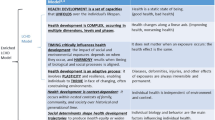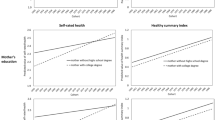Abstract
The complex relationship between life course and social/economic-psychosocial conditions in a given society has a powerful determining effect on human health. The socioeconomic gradient emerges from a complex mixture of psychosocial and material influences operating at various levels of social aggregation and, also, a series of biological responses whose character and significance vary over the life course. Biological embedding and the “latency” and “pathways” model incorporate the notion of a critical period in development; the pathways model emphasizes the cumulative effect of life events and the ongoing importance of social/economic-psychosocial conditions throughout the life cycle. The models, although conceptually complementary, result in ideological conflict and lend themselves to different policy directions.
Abrégé
Les liens complexes entre le cours de la vie et les conditions socio-économiques et psychosociales dans une société donnée ont un puissant effet déterminant sur la santé humaine. D’un mélange complexe d’influences psychosociales et matérielles qui s’exercent à divers niveaux de l’agrégation sociale, ainsi que d’une série de réponses biologiques dont le caractère et l’importance varient au cours de la vie, émerge un gradient socioéconomique de l’état de santé. L’enchâssement biologique et les modèles de la «latence» et des «cheminements» intègrent la notion d’une période critique dans le développement; le modèle des cheminements met l’accent sur l’effet cumulatif des événements vécus et sur l’importance soutenue des conditions socio-économiques et psychosociales pendant toute la vie. Les deux modèles, malgré leur complémentarité théorique, sont incompatibles sur le plan idéologique et se prêtent à des programmes d’action différents.
Similar content being viewed by others
Bibliographie
World Bank. World Development Report. Investing in Health. World Development Indicators. New York: Oxford University Press, 1993.
Wilkinson, RG. Income distribution and life expectancy. BMJ 1992;304:165–68.
Wilkinson, RG. National mortality rates: The impact of inequality. Am J Public Health 1992;82(8):1082–84.
Kaplan GA, Pamuk ER, Lynch JW, et al. Inequality in income and mortality in the United States: Analysis of mortality and potential pathways. BMJ 1996;312:999–1003.
Kunst AE, Mackenbach, JP. An International Comparison of Socio-economic Inequalities in Mortality. Rotterdam: Erasmus University, 1992.
Kunst AE, Guerts JJM, Berg J. Internation Variation in Socio-economic Inequalities in Selfreported Health. The Hague: Netherlands Central Bureau of Statistics, 1992.
Hertzman C, Wiens M. Child development and long-term outcomes: A population health perspective and summary of successful interventions. Soc Sci Med 1996;43(7):1083–95.
Kittner SJ, White LR, Farmer ME, et al. Methodological issues in screening for dementia: The problem of education adjustment. J Chron Dis 1986;39(3):163–70.
D’Arcy C. Education and socio-economic status as risk factors for dementia: Data from the Canadian Study of Health and Aging. Neurobiology of Aging 1994;14: S40.
Fratiglioni L, Jorm AF, Grut M, et al. Predicting dementia from the mini-mental state examination in an elderly population: The role of education. J Clin Epidemiol 1993;46(3):281–87.
Stern Y, Gurland B, Tatemichi TK, et al. Influence of education and occupation on the incidence of Alzheimer’s disease. JAMA 1994;271:1004–10.
Mortimer JA, Graves, AB. Education and other socioeconomic determinants of dementia and Alzheimer’s disease. Neurology 1993;43:S39-S44.
Evans DA, Beckett LA, Albert MS, et al. Level of education and change in cognitive function in a community population of older persons. Ann Epidemiol 1993;3(1):71–77.
Meaney M, Aitken D, Bhatnager S, et al. Effect of neonatal handling on age-related impairments associated with the hippocampus. Science 1988;239:766.
Barker D, Osmond C. Infant mortality, childhood nutrition, and ischaemic heart disease in England and Wales. Lancet 1986;May 10:1077–81.
Barker D, Osmond C, Golding J, et al. Growth in utero, blood pressure in childhood and adult life, and mortality from cardiovascular disease. BMJ 1989;298:564–67.
Barker D, Osmond C, Winter P, et al. Weight in infancy and death from ischaemic heart disease. Lancet 1989;September 9:577–80.
Barker D, Bull A, Osmond C, Simmonds S. Fetal and placental size and risk of hypertension in adult life. BMJ 1990;301:259–62.
Barker D. The intrauterine environment and adult cardiovascular disease. In: The Childhood Environment and Adult Disease. Wiley, Chichester: Ciba Foundation Symposium 1991;156:3–16.
Barker D, Martyn C. The maternal and fetal origins of cardiovascular disease. J Epidemiol Commun Health 1992;46:8–11.
Barker D, Godfrey K, Osmond C, Bull A. The relation of fetal length, ponderal index and head circumference to blood pressure and the risk of hypertension in adult life. Pediatric and Perinatal Epidemiology 1992;6:35–44.
Barker D, Meade T, Fall C, et al. Relation of fetal and infant growth to plasma fibrinogen and factor VII concentrations in adult life. BMJ 1992;304:148–52.
Barker D, Osmond C, Simmonds S, Wield G. The relation of small head circumference and thinness at birth to death from cardiovascular disease in adult life. BMJ 1993;306:422–26.
Schweinhart LJ, Barnes HV, Weikart, DP. Significant benefits: The High/Scope Perry preschool study through age 27. Monographs of the High/Scope Educational Research Foundation 1993;10.
Palmer, FH. Long-term gains from early intervention: Findings from longitudinal studies. In: Zigler E, Valentine J (Eds.), Project Head Start: A Legacy of the War on Poverty. New York: The Free Press, 1979.
Case R, Griffin S. Rightstart: An early intervention program for insuring that children’s first formal learning of arithmetic is grounded in their intuitive knowledge of numbers. Report to the James S. McDonnell Foundation, 1991.
Pulkkinen L, Tremblay, RE. Patterns of boys’ social adjustment in two cultures and at different ages: A longitudinal perspective. Int J Behav Dev 1992;15:527–53.
Power C, Manor O, Fox J. Health and Class: The Early Years. London: Chapman & Hall, 1991.
Haan M, Kaplan GA, Camacho T. Poverty and health: Prospective evidence from the Alameda County Study. Am J Epidemiol 1987;125:989–97.
Karasek R, Theorell T. Healthy Work: Stress, Productivity, and the Reconstruction of Working Life. New York: Basic Books, 1990.
Marmot M. Explaining Socioeconomic Differences in Sickness Absence: The Whitehall II Study. Toronto: Canadian Institute for Advanced Research, 1993.
Marmot M, Smith G, Stansfeld S, et al. Health inequalities among British Civil Servants: The Whitehall II Study. Lancet 1991;337:1387–93.
Marmot M, Kogevinas M, Elston M. Social/economic status and disease. Annu Rev Public Health 1987;8:111–35.
Wolfson M, Rowe G, Gentleman J, Tomiak M. Career earnings and death: A longitudinal analysis of older Canadian men. Canadian Institute for Advanced Research, Population Health Working Paper, 12, Toronto, 1991.
OECD and Statistics Canada. Literacy, Economy, and Society: Results of the First International Adult Literacy Survey. OECD/Ministry of Industry Canada, 1995.
Author information
Authors and Affiliations
Corresponding author
French language version/Version en Français
Rights and permissions
About this article
Cite this article
Hertzman, C. The Case for Child Development as a Determinant of Health. Can J Public Health 89 (Suppl 1), S16–S21 (1998). https://doi.org/10.1007/BF03405090
Published:
Issue Date:
DOI: https://doi.org/10.1007/BF03405090




